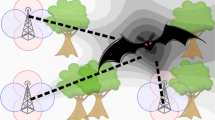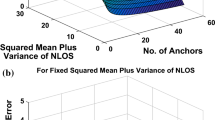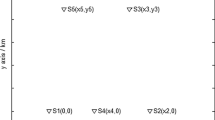Abstract
In this study, a new powerful geometrical closed-form solution called Direction of Exponent Uncertainty (DEU) is proposed for received signal strength (RSS) based far-field localization when path loss exponent (PLE) and transmit power are both unknown. The uncertainty in the PLE due to environmental factors is a significant challenge for RSS based localization. DEU is built after careful investigation of geometrical behaviors of differential received signal strength circles, i.e. the locus of possible location of the emitter when transmit power is unknown. It is shown that the uncertainty in the PLE corresponds to a linear uncertainty for the location of the emitter in two dimensional space. This critical observation creates a basis for the sensor to move towards the emitter without estimating the emitter location after only three measurements. Furthermore, with only four different measurements, it is possible to effectively estimate the location of the emitter as well as the PLE by means of intersection of DEUs. Intersection of DEUs attains Cramer Rao Lower Bound with a dramatically reduced execution time compared to nonlinear least squares estimator. DEU is also proposed as an efficient route planning tool for moving sensors such as unmanned aerial vehicles.












Similar content being viewed by others
References
Gezici, S. (2008). A survey on wireless position estimation. Wireless Personal Communications, 44(3), 263–282.
Zekavat, R., & Buehrer, R. M. (2011). Handbook of position location: Theory, practice and advances. Singapore: Wiley.
Jin, R., Che, Z., Xu, H., Wang, Z., & Wang, L. (2015). An RSSI-based localization algorithm for outliers suppression in wireless sensor networks. Wireless Networks, 21(8), 2561–2569.
Ren, L., Chen, X., Xie, B., Tang, Z., Xing, T., Liu, C., et al. (2016). DE2: Localization based on the rotating RSS using a single beacon. Wireless Networks, 22(2), 703–721.
Liu, C., Wu, K., & He, T. (2004). Sensor localization with ring overlapping based on comparison of received signal strength indicator. In IEEE international conference on mobile ad hoc and sensor systems (pp. 516–518).
Patwari, N., Ash, J. N., Kyperountas, S., Hero, A. O., III, Moses, R. L., & Correal, N. S. (2005). Locating the nodes: Cooperative localization in wireless sensor networks. Signal Processing Magazine, 22(4), 54–69.
Wang, G., & Yang, K. (2009). Efficient semidefinite relaxation for energy-based source localization in sensor networks. In IEEE international conference on acoustics, speech and signal processing (ICASSP 2009) (pp. 2257–2260).
Lee, J. H., & Buehrer, R. M. (2009). Location estimation using differential RSS with spatially correlated shadowing. In Global telecommunications conference (GLOBECOM 2009) (pp. 1–6).
Wang, S., & Inkol, R. (2011). A near-optimal least squares solution to received signal strength difference based geolocation. In IEEE international conference on acoustics, speech and signal processing (ICASSP 2011) (pp. 2600–2603).
Jackson, B. R., Wang, S., & Inkol, R. (2011). Received signal strength difference emitter geolocation least squares algorithm comparison. In 24th Canadian conference on electrical and computer engineering (CCECE 2011) (pp. 001113–001118).
Lee, J. H. (2011). Physical layer security for wireless position location in the presence of location spoofing. Ph.D. Dissertation, Virginia Technology University.
Lee, J. H., & Buehrer, R. M. (2012). Fundamentals of received signal strength-based position location. In R. Zekavat & R. M. Buehrer (Eds.), Handbook of position location: Theory, practice, and advances (pp. 359–394). Singapore: Wiley.
Lin, L., So, H. C., & Chan, Y. T. (2013). Accurate and simple source localization using differential received signal strength. Digital Signal Processing, 23(3), 736–743.
Wang, S., Inkol, R., & Jackson, B. R. (2012). Relationship between the maximum likelihood emitter location estimators based on received signal strength (RSS) and received signal strength difference (RSSD). In 26th Biennial symposium on communications (QBSC 2012) (pp. 64–69).
Taylor, R. C. (2013). Received signal strength-based localization of non-collaborative emitters in the presence of correlated shadowing. M.S. Thesis, Virginia Technology University.
Tsui, A. W., Chuang, Y. H., & Chu, H. H. (2009). Unsupervised learning for solving RSS hardware variance problem in WiFi localization. Mobile Networks and Applications, 14(5), 677–691.
Cheng, W., Tan, K., Omwando, V., Zhu, J., & Mohapatra, P. (2013). RSS-ratio for enhancing performance of RSS-based applications. In INFOCOM 2013 (pp. 3075–3083).
Cai, L., Zeng, K., Chen, H., & Mohapatra, P. (2011). Good neighbor: Secure pairing of nearby wireless devices by multiple antennas. In 18th Annual network and distributed system security symposium.
Lohrasbipeydeh, H., Gulliver, T. A., & Amindavar, H. (2014). Blind received signal strength difference based source localization with system parameter errors. IEEE Transactions on Signal Processing, 62(17), 4516–4531.
Sternowski, R. (2016) Power difference of arrival geolocation. U.S. Patent No. 9,316,719. 19 April 2016.
Li, X. (2006). RSS-based location estimation with unknown pathloss model. IEEE Transactions on Wireless Communications, 5(12), 3626–3633.
Shirahama, J., & Ohtsuki, T. (2008). RSS-based localization in environments with different path loss exponent for each link. In Vehicular technology conference (pp. 1509–1513).
Mao, G., Anderson, B. D., & Fidan, B. (2007). Path loss exponent estimation for wireless sensor network localization. Computer Networks, 51(10), 2467–2483.
Chan, Y. T., Lee, B. H., Inkol, R., & Chan, F. (2011). Received signal strength localization with an unknown path loss exponent. In 24th Canadian conference on electrical and computer engineering (CCECE) (pp. 456–459).
Wang, G. C., Chen, H., Li, Y., & Jin, M. (2012). On received-signal-strength based localization with unknown transmit power and path loss exponent. Wireless Communications Letters, 1(5), 536–539.
Salman, N. G. (2012). On the joint estimation of the RSS-based location and path-loss exponent. Wireless Communications Letters, 1(1), 34–37.
Chan, Y. T., Lee, B. H., Inkol, R. J., & Chan, F. (2012). Estimation of emitter power, location, and path loss exponent. In Proceedings of CCECE (pp. 1–5).
Gholami, M. R., Vaghefi, R. M., & Ström, E. G. (2013). RSS-based sensor localization in the presence of unknown channel parameters. IEEE Transactions on Signal Processing, 61(15), 3752–3759.
Scerri, P., Glinton, R., Owens, S., Scerri, D., & Sycara, K. (2007). Geolocation of RF emitters by many UAVs. In AIAA Infotech@ Aerospace 2007 Conference and Exhibit (pp. 2858).
Dehghan, S. M. M., Moradi, H., & Shahidian, S. A. A. (2014). Optimal path planning for DRSSI based localization of an RF source by multiple UAVs. In RSI/ISM International Conference on Robotics and Mechatronics (ICRoM) (pp. 558–563).
Shahidian, S. A. A., & Soltanizadeh, H. (2015). Optimal trajectories for two UAVs in localization of multiple RF sources. Transactions of the Institute of Measurement and Control, 38(8), 908–916.
Shin, H. S., de Corlieu, T., & Tsourdos, A. (2014). Civil GPS jammer geolocation from a UAV equipped with a received signal strength indicator sensor. In Proceedings of international conference on intelligent unmanned systems.
Sono, H., Ohno, A., Kojima, T., & Yamane, Y. (2007). Retrospective estimation of the spatial dose distribution and the number of fissions in criticality accident using area dosimeters. Journal of Nuclear Science and Technology, 44(1), 43–53.
Traa, J. (2013). Least squares intersection of lines. http://cal.cs.illinois.edu/~johannes/research/LS_line_intersect.pdf. Accessed 01 Feb 2015.
Kay, S. M. (1993). Fundamentals of statistical signal processing, Volume I: Estimation theory. Upper Saddle River, NJ: Prentice Hall.
Patwari, N., Hero, A. O., Perkins, M., Correal, N. S., & O’dea, R. J. (2003). Relative location estimation in wireless sensor networks. IEEE Transactions on Signal Processing, 51(8), 2137–2148.
MATLAB 2014b, The MathWorks, Inc., Natick, Massachusetts, United States, License Number: 991708.
Acknowledgements
This study is funded by TUBITAK (The Scientific and Technological Research Council of Turkey) with the project number 115E185 and by Anadolu University with the project number 1606F559.
Author information
Authors and Affiliations
Corresponding author
Electronic supplementary material
Below is the link to the electronic supplementary material.
Video 1. A descriptive video about DEU based tracking. https://youtu.be/nGyzCvXR8SM. (AVI 27362 kb)
Video 2. An illustrative sample video about the emitter tracking simulations. https://youtu.be/NF26-Y6C_q4. (MP4 1240 kb)
Appendices
Appendix A: Tracking algorithms’ flowcharts
See Fig. 13.
Tracking algorithms’ flowcharts for Sect. 5.2
Appendix B: Limitation about DEU
In this section, we would like to mention that the guess points with respect to different nguess values lose their ability to align linearly for linear measurement patterns. Linear measurement patterns which are not preferable because of bringing the issue of mirror effect in localization are also problematic in yielding linear DEU structures as shown in Fig. 14a. However, the DEUs can quickly recover their linear patterns for even very small angular deviation from linear measurement. Figure 14b illustrates how DEUs are perfectly reconstructed for only 30 degrees deviation from linear measurement. Therefore, a sensor moving along a linear path can make a small deviation from the line of motion, if it wants to check its direction by means of DEU.
Rights and permissions
About this article
Cite this article
Uluskan, S., Filik, T. A geometrical closed form solution for RSS based far-field localization: Direction of Exponent Uncertainty. Wireless Netw 25, 215–227 (2019). https://doi.org/10.1007/s11276-017-1553-7
Published:
Issue Date:
DOI: https://doi.org/10.1007/s11276-017-1553-7






